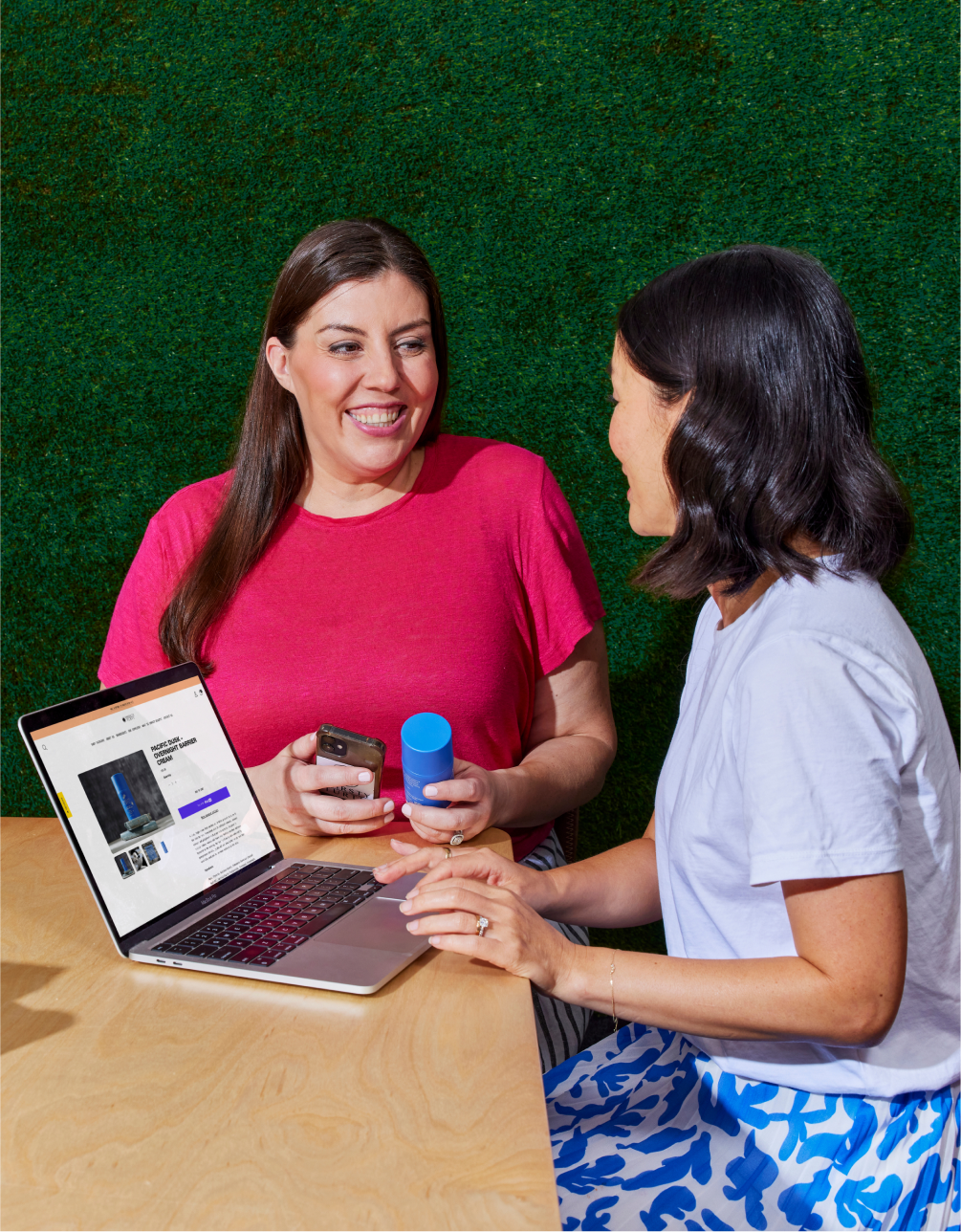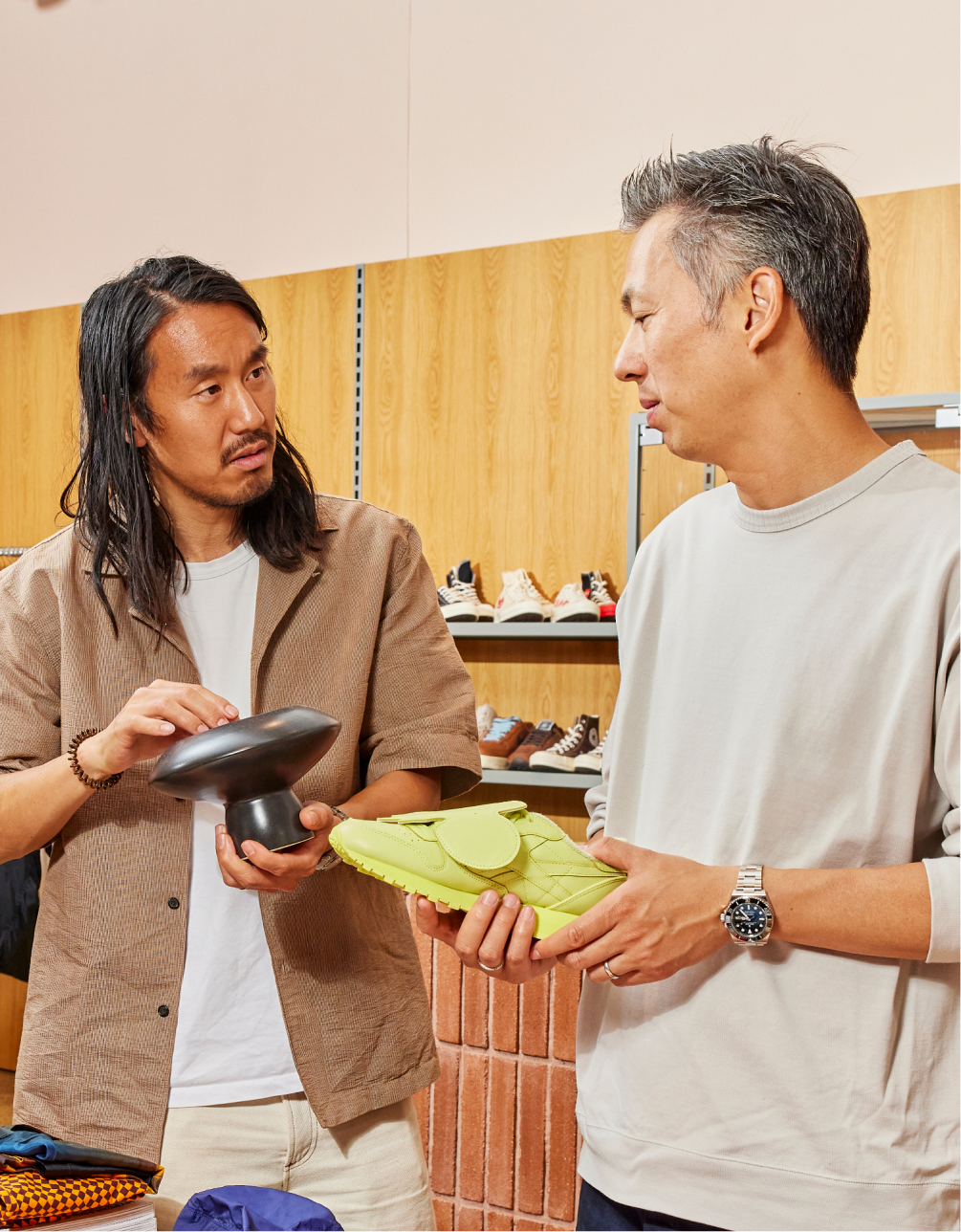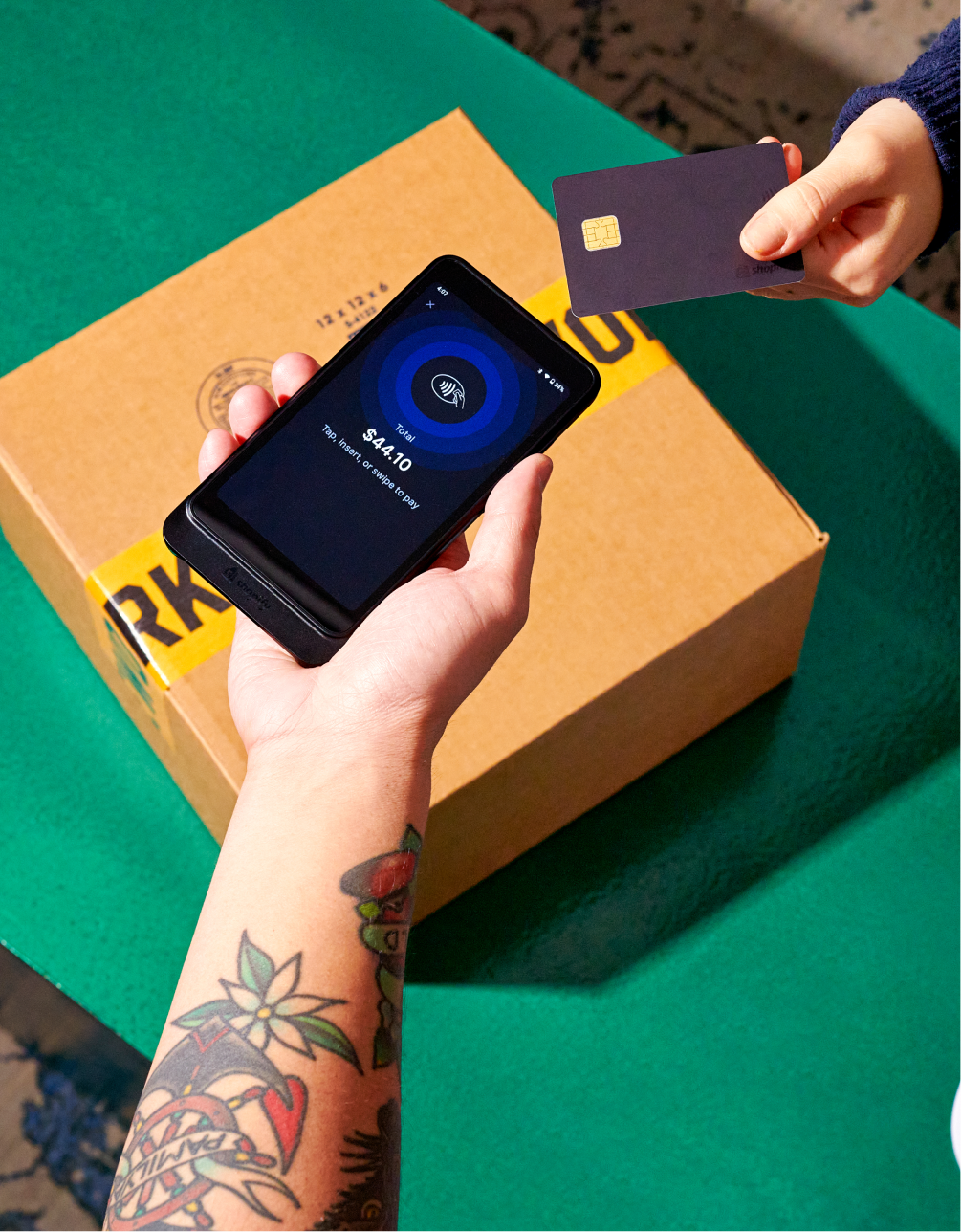Live commerce is here to stay.
Since it took off in Asia, experts haven’t quite agreed on how the live commerce hype will pan out in Western countries. But the verdict’s in: live commerce is still on an upward trajectory, with Coresight Research—a firm that studies retail and technology—projecting that livestream sales in the United States will reach $32 billion by the end of 2023.
Coresight’s CEO Deborah Weinswig adjusted this prediction to $50 billion for CNBC, with an estimate that livestream shopping will account for more than 5% of total ecommerce sales in the US by 2026.
Live shopping merges the best of offline and online shopping experiences, making a purchase about more than just the transaction: it’s engaging, fun, and can build long-term trust. Here’s what live shopping can do for your ecommerce business and how to get started, as well as the platforms to consider for livestream selling and tips to make your live shopping campaigns successful.
What is live shopping?
Live shopping is a marketing strategy based on livestreaming, where a host presents products and viewers can purchase those products in real time.
Live shopping gives brands a chance to interact with their customers and their target audience on their own websites and social media channels, but that’s not the only way live shopping takes place. Influencers can also run these livestreams, as can everyday people—the latter thanks to platforms like Amazon Live and Poshmark’s Posh Shows.
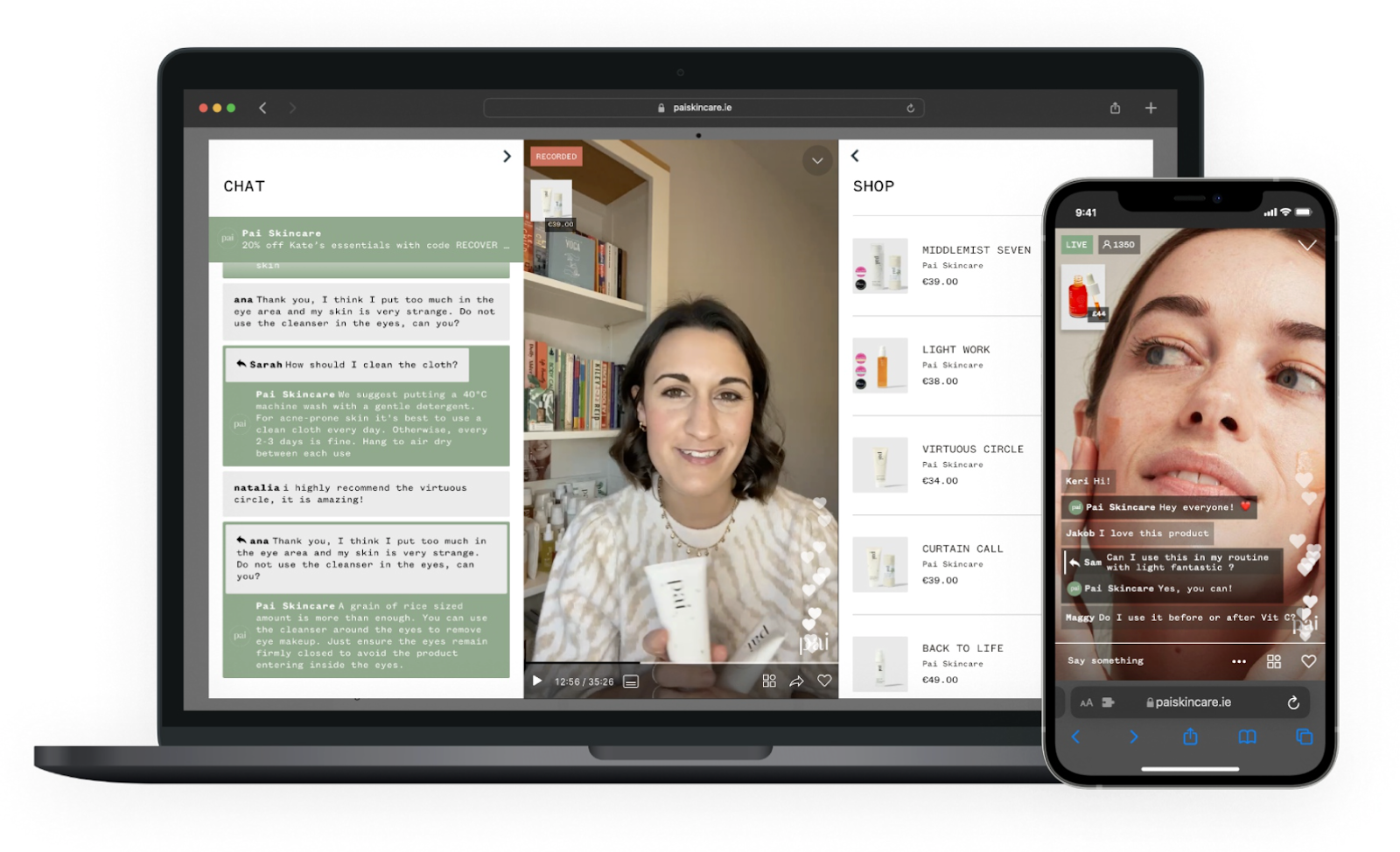
An example of a live shopping event by Pai Skincare. (source)
The concept of using live video to promote products and encourage people to buy isn’t new. Home Shopping Network pioneered the concept of a televised sales pitch for consumer products like home goods, beauty, and fashion back in the ’80s, inviting viewers to make a phone call to order products they just saw on their TV screens.
Today’s iteration isn’t much different—just swap televisions for mobile phones, TV networks for social media platforms, and “Call Now” hotlines for Buy Now buttons. Otherwise, the key elements of social selling are still the same: there’s a real-time feedback loop for buyers, including reviews of products, demonstrations, and the opportunity to ask questions.
This online version of live shopping emerged in China in the 2010s and it hasn’t stopped growing since. As of 2022, almost half a billion people in China used live shopping platforms. Western countries aren’t there yet, but they’re catching up: 20% of shoppers in the US and 24% of shoppers in Denmark participated in a live shopping event in 2022.
There’s opportunity and potential in embracing a live shopping strategy. Here’s what you need to know to take advantage of it.
How does live shopping work?
Live shopping has three core elements:
It’s in a video format
It’s happening in real time (as opposed to being pre-recorded)
It points to products customers can buy (through links, tags, pinned comments, and other online elements)
A live shopping event can take place on social media, on native live shopping platforms, or on a merchant’s website or mobile app (more on those later).
There are usually one or more people presenting products during a live stream—for example, trying the products on, demonstrating how to use them, presenting the products’ benefits, or sharing tips to make the most out of them.
Livestream viewers can interact with the host(s) via live chat to share thoughts about a product or ask questions that would help them buy the right product for their needs.
Around the video screen, viewers can view and click on links for products mentioned in the livestream, usually as a pop-up, sidebar, or pinned comment. Depending on the platform, they can either view and buy products within the interface itself or be taken to the brand’s website to complete the purchase.
Brands often offer discount codes and other special offers and bonuses that are valid only during the livestream, making it more valuable for customers to watch and participate live.
What are the benefits of tapping into live shopping?
Live shopping is just one of several ways customers can shop online, along with online marketplaces, brand websites, social commerce, voice commerce, and more.
Yet it has a 32% purchase incidence (for comparison, brand websites have a 53% purchase incidence).
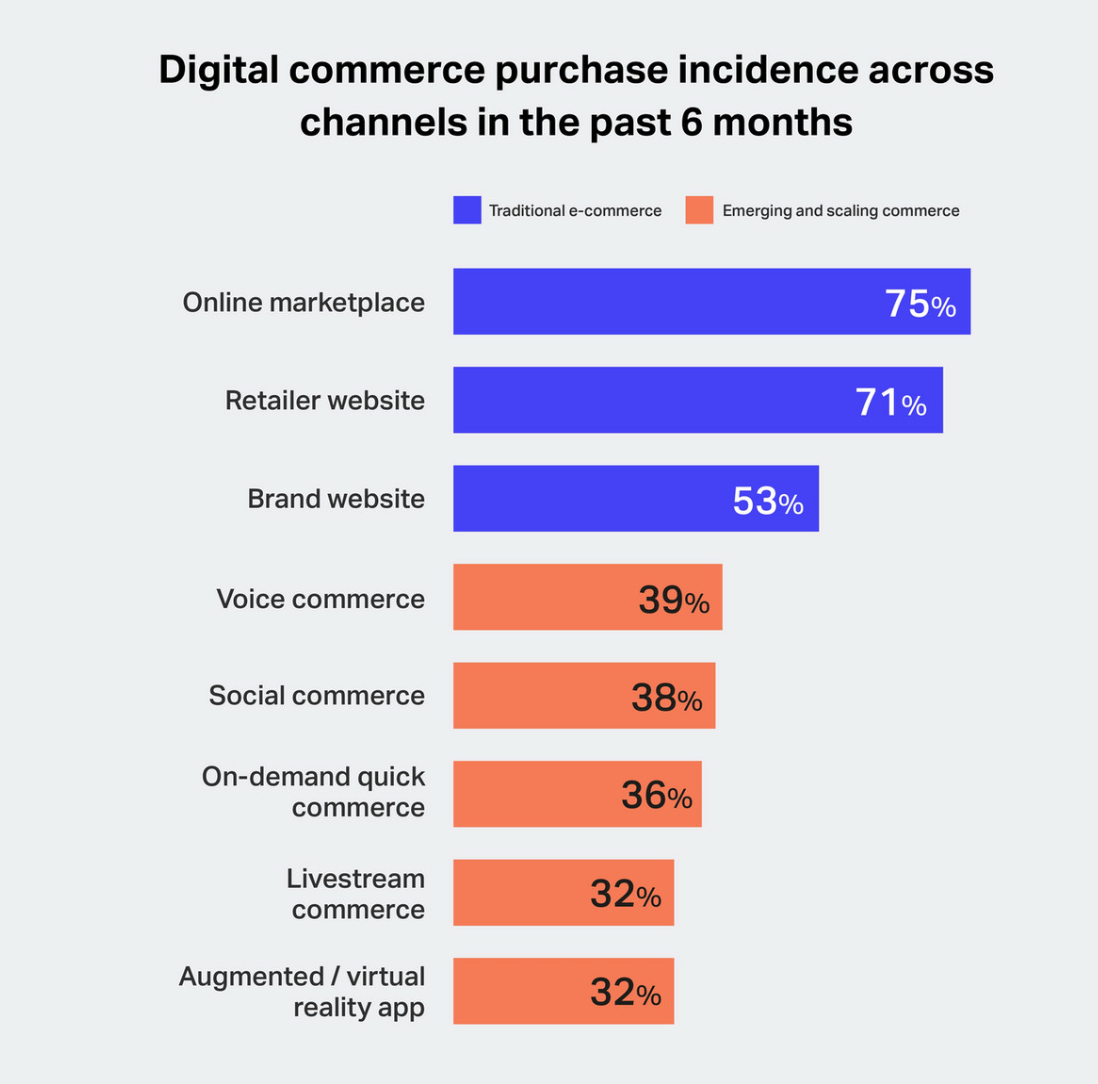
Digital commerce purchase incidence, reported by WARC and IPSOS.
Here’s why—and why you need to pay attention to live stream selling.
Better informed, inspired, and engaged customers
Live streaming lets you fit more product information into a shorter period of time. Instead of making a potential customer do all the work—identify the right products, look for reviews, watch multiple videos, view dozens of photos on the product page—you can provide everything they want to know in a matter of minutes during a live broadcast.
Not just that: You can also inspire, educate, and entertain your viewer at the same time, which can make your brand more memorable.
While having access to exclusive discounts is the leading benefit of live shopping for consumers, it’s followed closely by inspiration and ideas, smarter shopping, real-time engagement, and product recommendations. In other words, offering discounts is the easiest part of the campaign, and it will lead new viewers and customers to you; giving them deeper value and sparking engagement is what will keep them around.
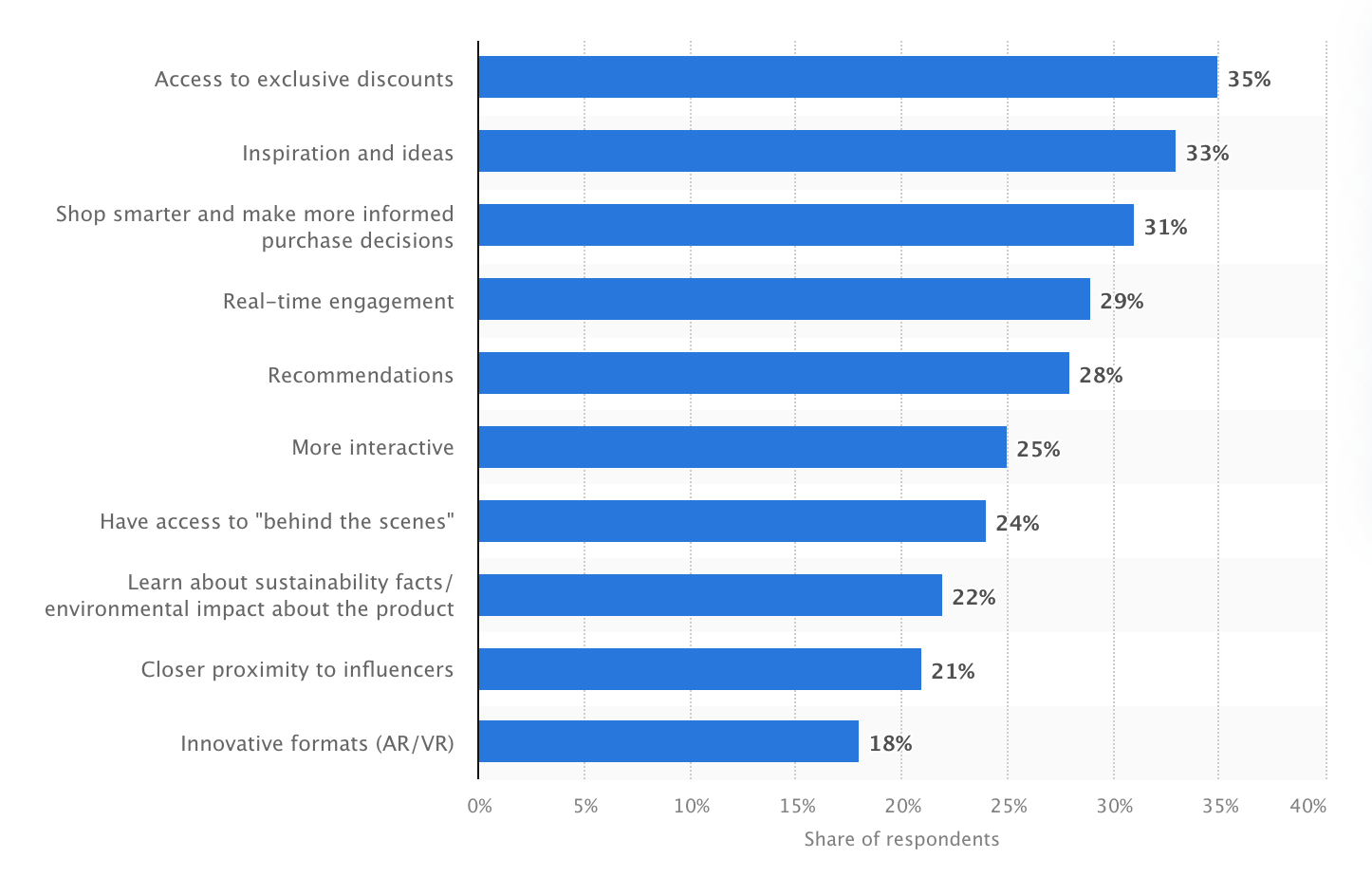
Perceived benefits of livestream shopping worldwide in 2022. (source)
A report from Coresight Research confirmed that educational content has the biggest influence on customers during shoppable livestreams, as well as livestreams hosted by experts.
Higher conversion rates and more successful launches
Live shopping can level up your product launches and overall conversion rates.
Take Tru Earth, an eco-friendly laundry detergent company. The brand regularly sees a jump in website traffic and customer engagement during live shopping events. “We saw a 20% increase in conversions during a recent product launch,” says Ryan McKenzie, Tru Earth’s co-founder. “The live shopping event contributed to a significant chunk of the revenue for the day.”
Another example comes from Buywith, a live shopping platform. According to TechCrunch, the platform delivers an eight-fold increase in conversions, a 40% increase in engagement rate, and a 10 times return-on-investment to its clients.
And Pai Skincare sees a 17% conversion rate from live shopping, six times higher than the beauty and skin care industry average.
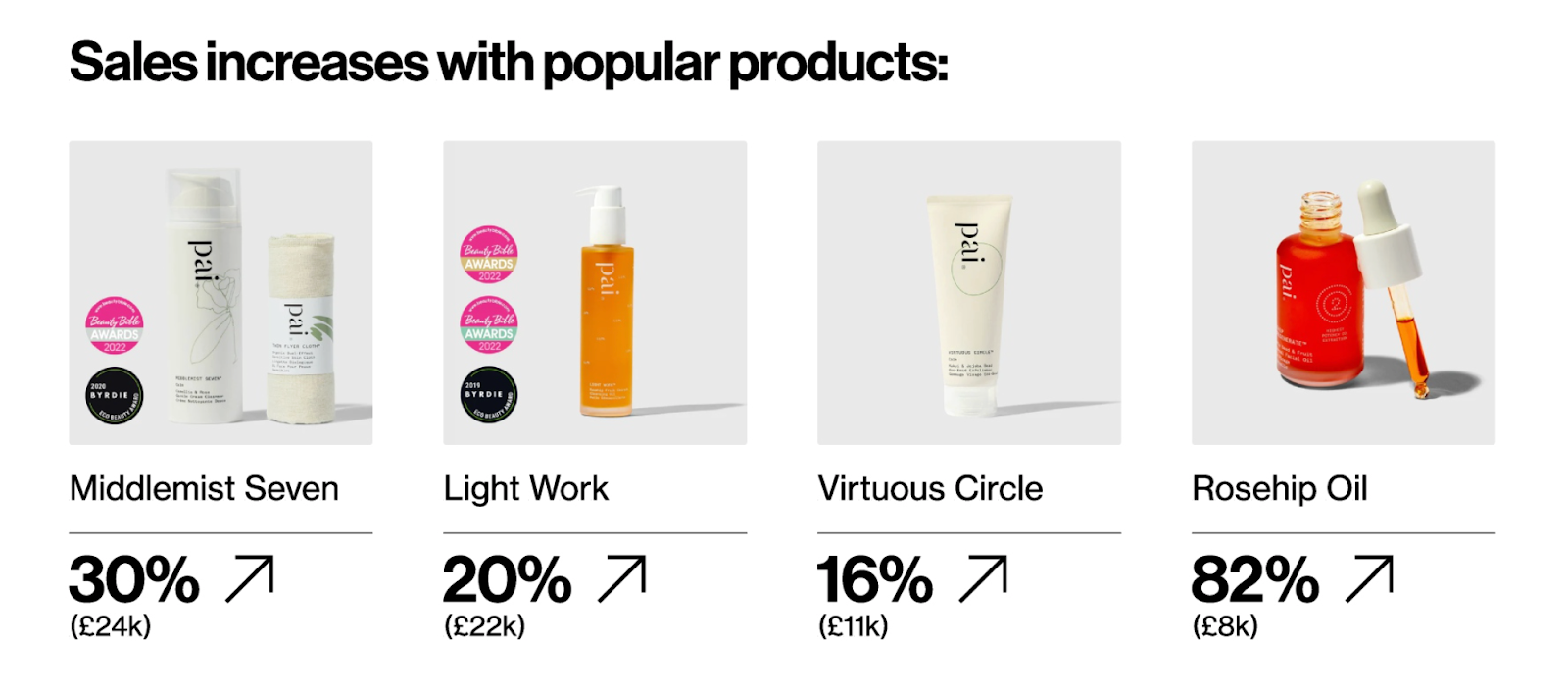
Pai Skincare + Bambuser case study (source)
Lower return rates
Another well-documented benefit of live shopping events: even if a lower number of customers convert, they are considerably less likely to return items. According to Coresight data, live shoppers are 40% less likely to return an item than other online shoppers.
“Live streaming is an opportunity to educate the consumer, which is why returns are so much lower—they actually know what they’re buying,” Deborah Weinswig, Coresight’s CEO, told Retail TouchPoints.
Potential to become a long-term growth channel
With those impressive results, it’s likely that, for many brands that gave live shopping campaigns a try, going back isn’t an option.
Another Coresight Research study showed that regularly scheduled live shopping events can make it easier for brands to build a base of repeat viewers, especially because over half of livestream viewers reported watching shoppable livestreams multiple times per week.
Just like paid ads, SEO, and influencer marketing, live shopping can become a key piece of the marketing puzzle for many brands who crave long-term results.
Coresight estimates that livestream shopping will account for more than 5% of all ecommerce sales in the United States by 2026. Companies working to establish themselves with livestreaming could see upward of 25% top-line growth, Weinswig told CNBC.
In other words, the time for your business to give live shopping a chance is now.
How to get started with live shopping
Follow these steps to pilot your first live shopping stream. The running theme is “keep it simple,” so you can learn from the experience and expand with future event iterations:
Choose several products you want to promote. Go with no more than 10 products; you can start with your bestsellers, or products from your most recent launch. This will help you build your messaging around the sale when promoting the event, too.
Pick a date, time, and length of your live shopping event. For your first live shopping session, avoid a popular shopping period like Black Friday and opt for a low-risk route. Pick your time based on the predominant time zone of your existing audience and customer base.
Select a format. Some examples include interviews with an expert or an influencer, a how-to tutorial (for example, a styling demo), or a behind-the-scenes format that showcases how you prepare orders for shipping. Prepare an outline with what you’ll cover based on the format and products you’ve picked.
Decide where you’ll host your event. YouTube is one of the simplest options; check out more options in the next section. The key is to focus on only one option, instead of trying to stream to five platforms at once.
Promote your livestream shopping event. Lean on your usual marketing channels to let your audience know when and where they can interact with your brand live, as well as what to expect from the event: its length, the discounts and bonuses you’ll offer, and the general format.
Prepare your tech. Based on the event format you chose, make sure you have all the equipment you need, including a web camera, additional lights, a tripod, and any apps you’ll use.
Live shopping platforms
Tools for livestream shopping fall into one of three categories:
Social media platforms
Live shopping tools for ecommerce brands
Live shopping platforms
1. Social media platforms
This category features already-well-known social media platforms that have merged their livestreaming capabilities with ecommerce features.
It’s worth pointing out that Facebook and Instagram used to be in this category, but Meta shut down its live shopping capabilities on those platforms in 2022 and 2023, respectively.
YouTube
Being a Google brand, it’s no wonder YouTube leads the way with shopping capabilities. The barrier to entry is next to none, especially since YouTube has partnered with Shopify and made it easy for merchants to import products from their catalog.
POPFLEX, a Shopify merchant run by the popular fitness creator Cassey Ho of Blogilates, had its second-highest sales hour of the year thanks to a YouTube livestream in November 2022.
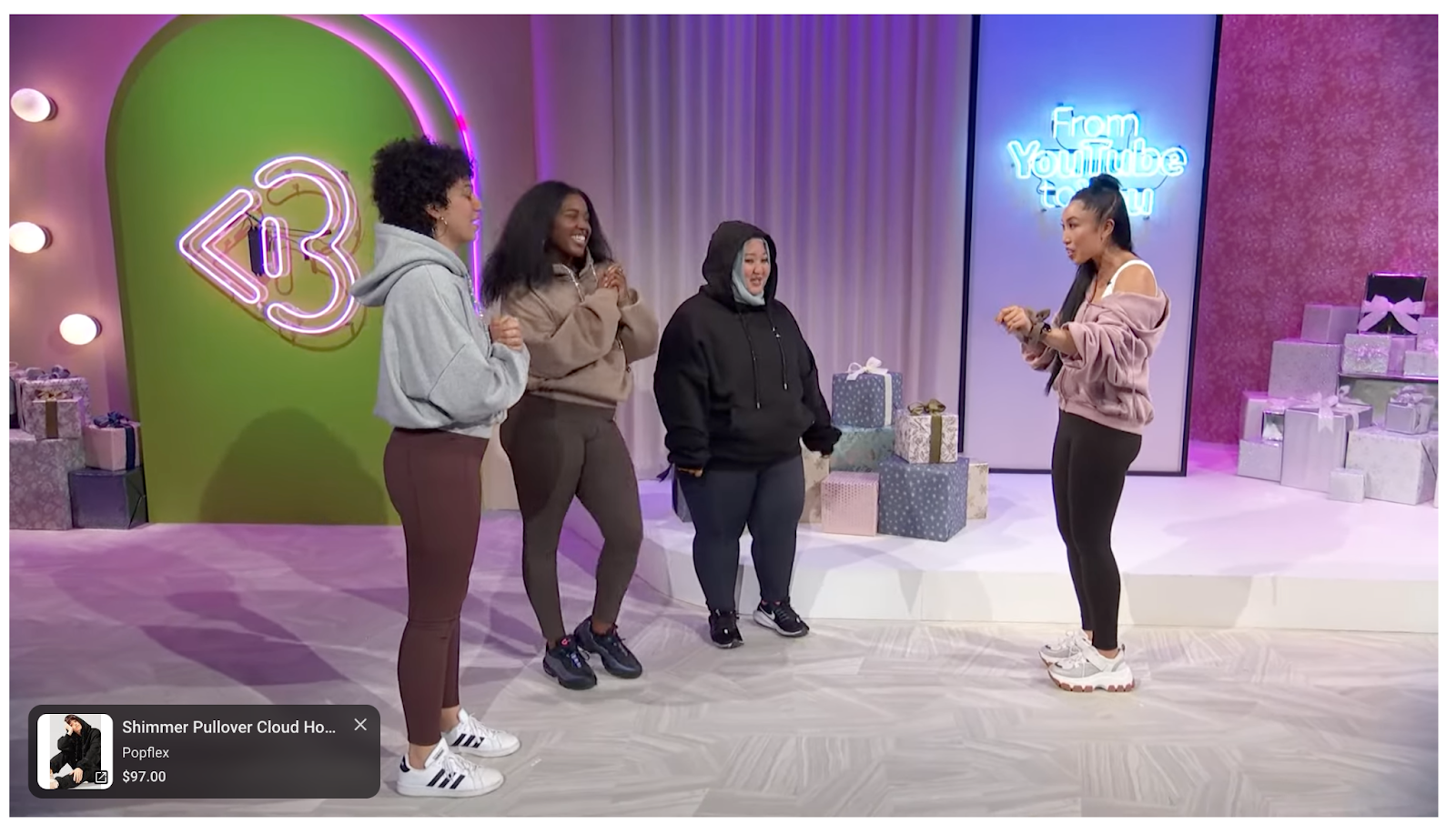
POPFLEX’s live shopping event on YouTube. (source)
TikTok
TikTok has established itself as the crossover between entertainment and shopping. “TikTok made me buy it” search has collected more than seven billion views, and the platform often is blamed for selling out many products in record time.
If you’re in one of the countries where the TikTok Shop feature is available—as of mid-2023, that includes the United States, the United Kingdom, Indonesia, Malaysia, Thailand, Philippines, Vietnam, and Singapore—it’s worth trying.
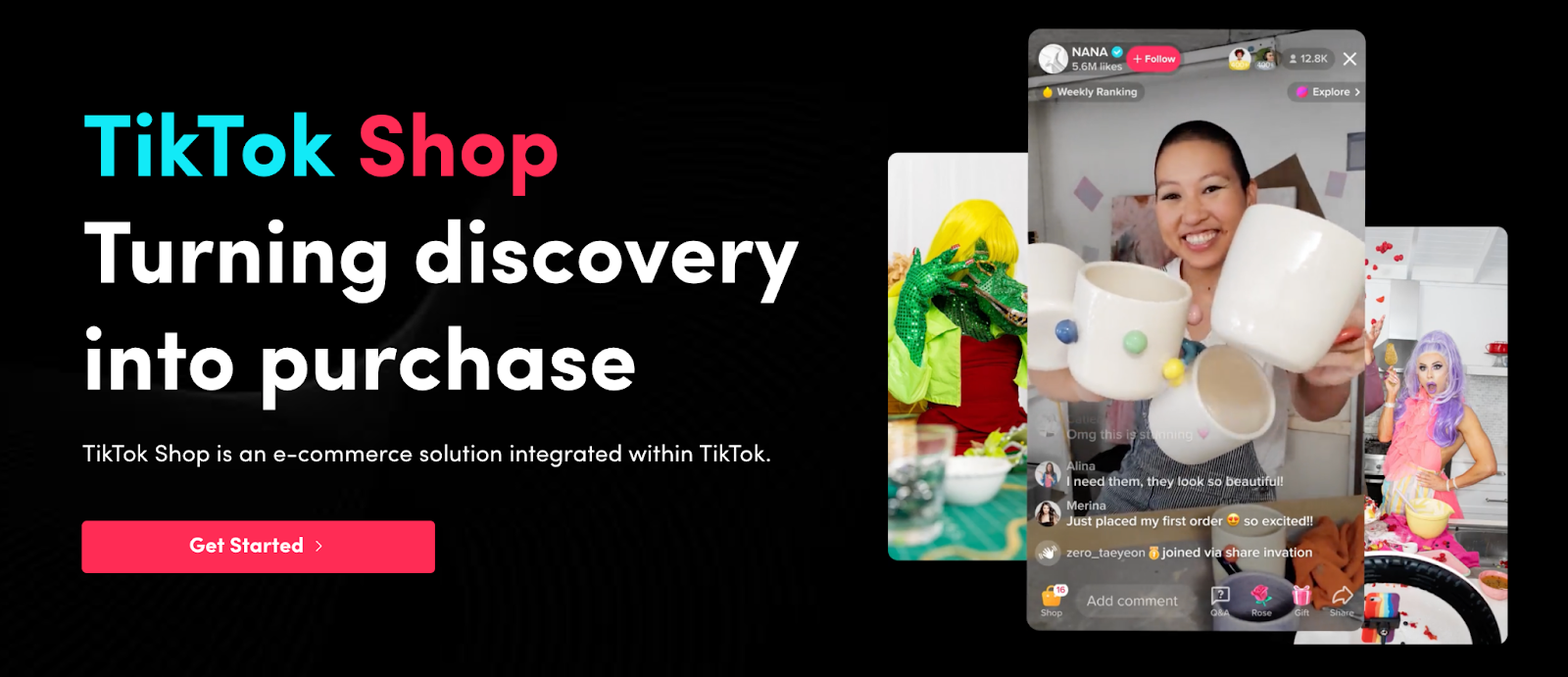
TikTok Shop. (source)
Pinterest TV
Pinterest launched Pinterest TV—a curated series of live, original, and shoppable episodes—back in late 2021. It originally featured hand-selected creators, but now all creators are eligible to apply.
Ahead of the 2022 holiday season, Pinterest TV launched a holiday shopping event, featuring shoppable content from brands like JENNY BIRD, Wayfair, NUDESTIX, and more— becoming another option in the live shopping playing field for merchants.
Pinterest TV is currently limited location-wise to the US, Canada, Australia, the UK, and Germany.
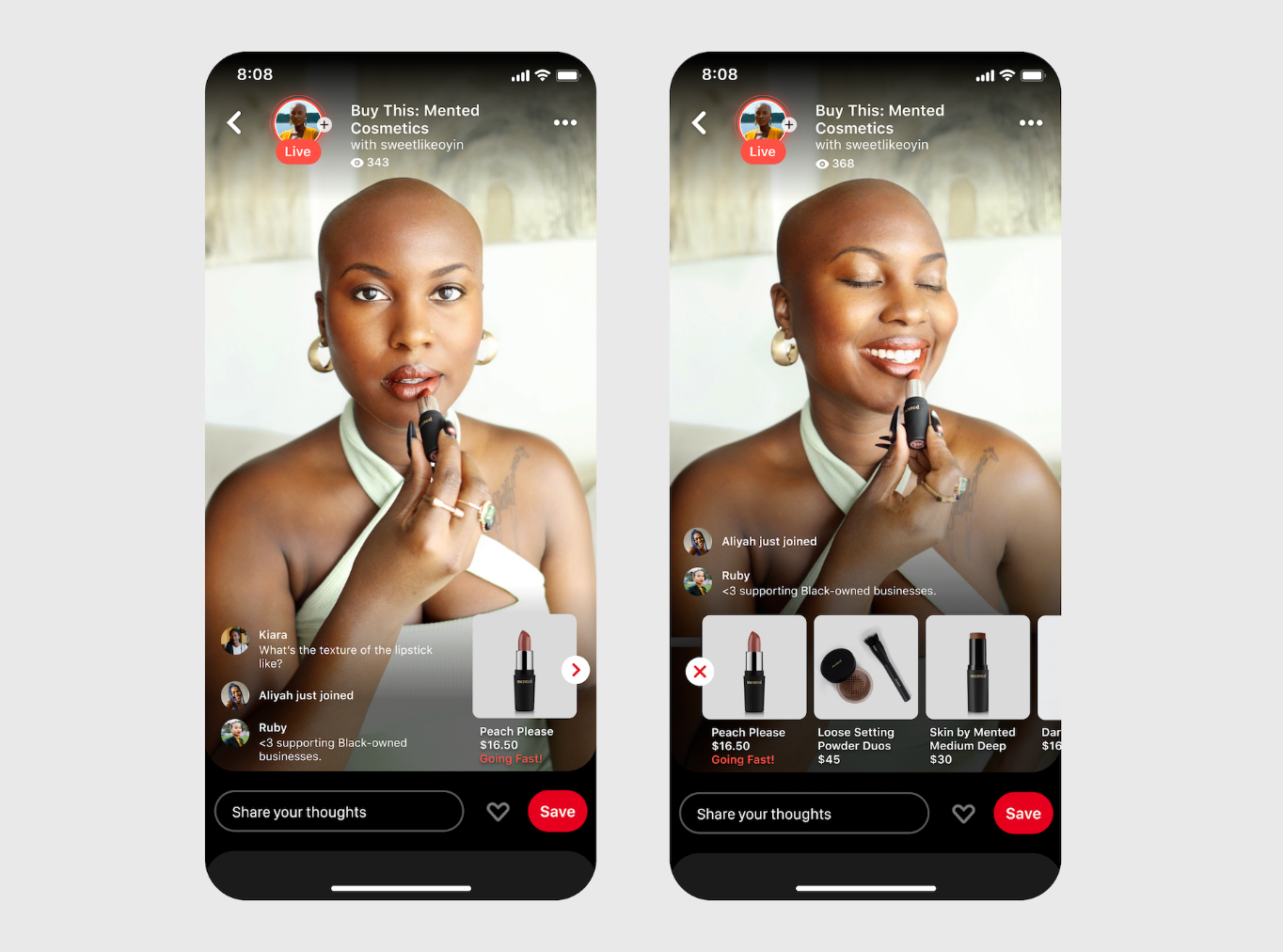
Pinterest TV (source)
2. Live shopping tools for ecommerce brands
These are tools that are made to integrate with an ecommerce brand’s existing tech stack, like its ecommerce platform and website, to run live shopping sessions.
This isn’t an exhaustive list of options, but it’s a great place to start:
Bambuser
Bambuser is a live video shopping technology that lets you make existing videos shoppable or run interactive live shopping sessions. On top of running a one-to-many event—a typical live stream format—you can also use it to run one-on-one shopping sessions with individual customers.
Bambuser serves merchants both big and small, including Bloomingdale’s, Pai Skincare, HUGO BOSS. Shopify merchants can easily integrate Bambuser into their store.
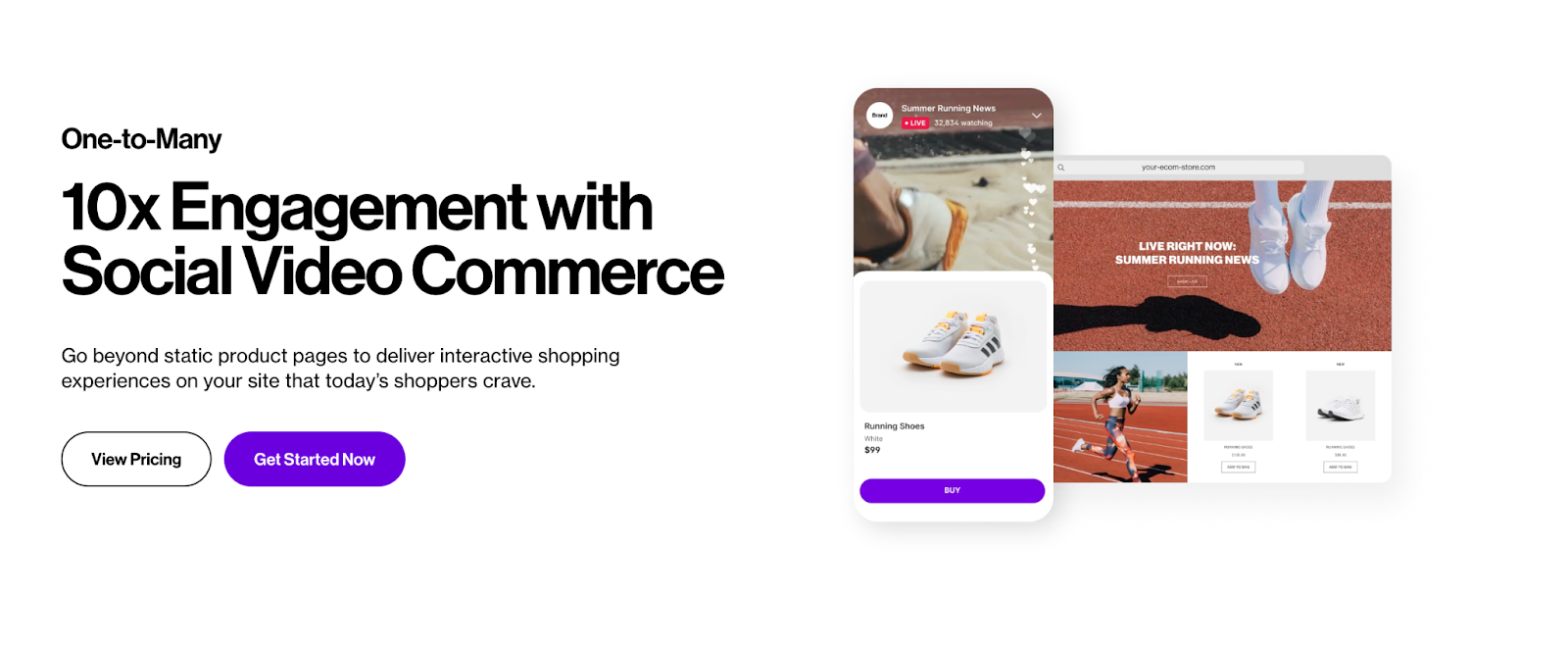
Bambuser’s one-to-many product. (source)
Now Live
Now Live is a live shopping software built specifically for Shopify stores that lets customers browse and buy products from a live video using a checkout process they already know and trust.
Jewelry brand Modern Gents uses Now Live’s solution; here’s what one of its event signup pages looks like.
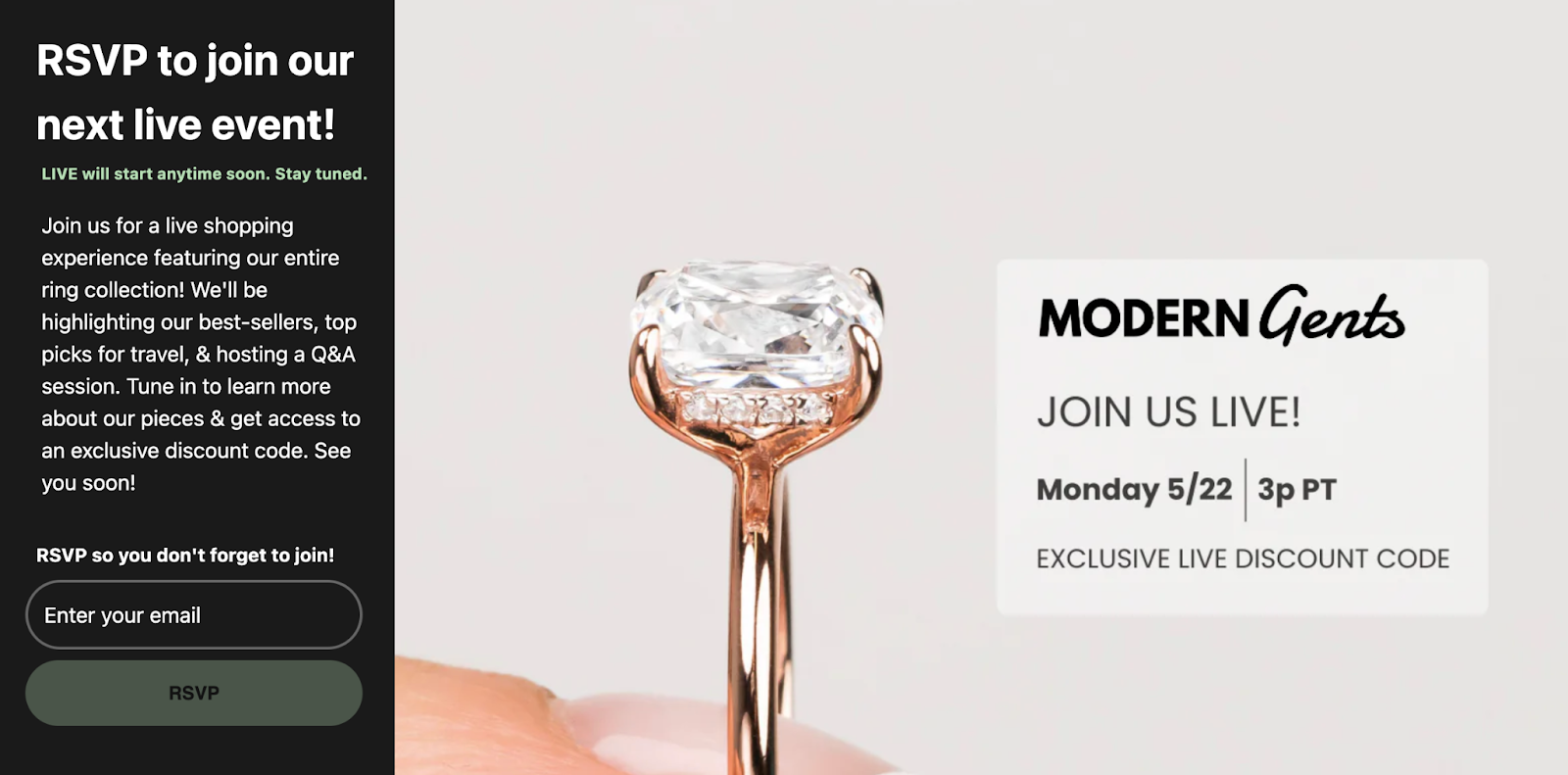
Modern Gents’ event page (source)
Livescale
Livescale is a live shopping solution trusted by brands like Kiehl’s, Dermalogica, Tatcha, and Giorgio Armani. Livescale stands out by smartly promoting its customers’ upcoming live shopping sessions, on both its website and its social media channels.
Shopify merchants like Three Ships Beauty love Livescale. “In our first one-hour event, we garnered over 350 orders from high LTV customers. Using Livescale is now a pillar of our marketing strategy—we promote an event for every product launch and large promo,” reads the review by Three Ships Beauty on the Livescale + Shopify page.
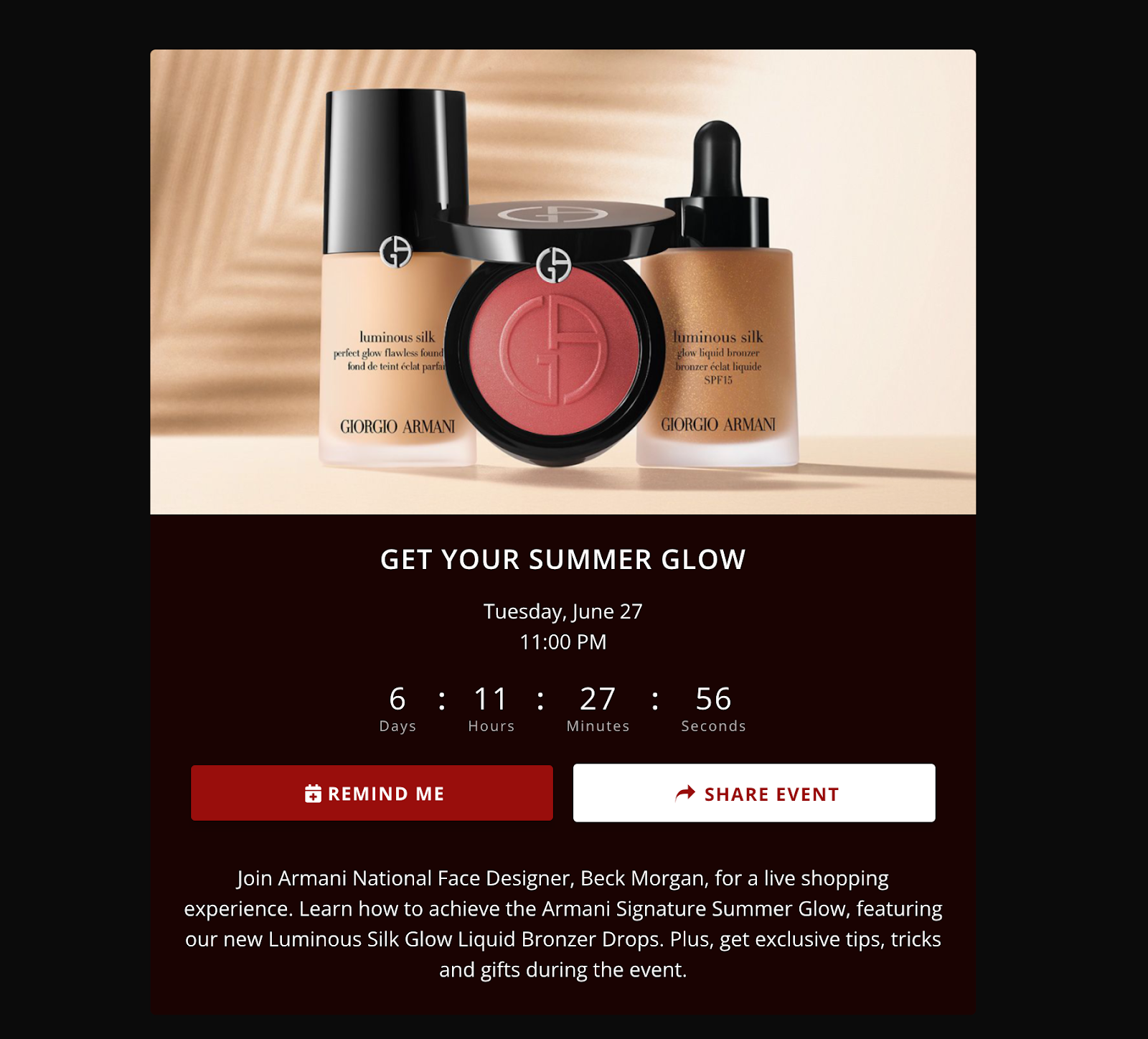
An upcoming live shopping event on Livescale by Giorgio Armani. (source)
Emplifi
Emplifi offers both one-to-one and one-to-many live shopping solutions, alongside several other social media and social commerce features. It serves brands like Pandora, HP, and Marks & Spencer.
During a livestream, merchants can choose to take one-to-one video calls with viewers who need more assistance during their shopping journey.
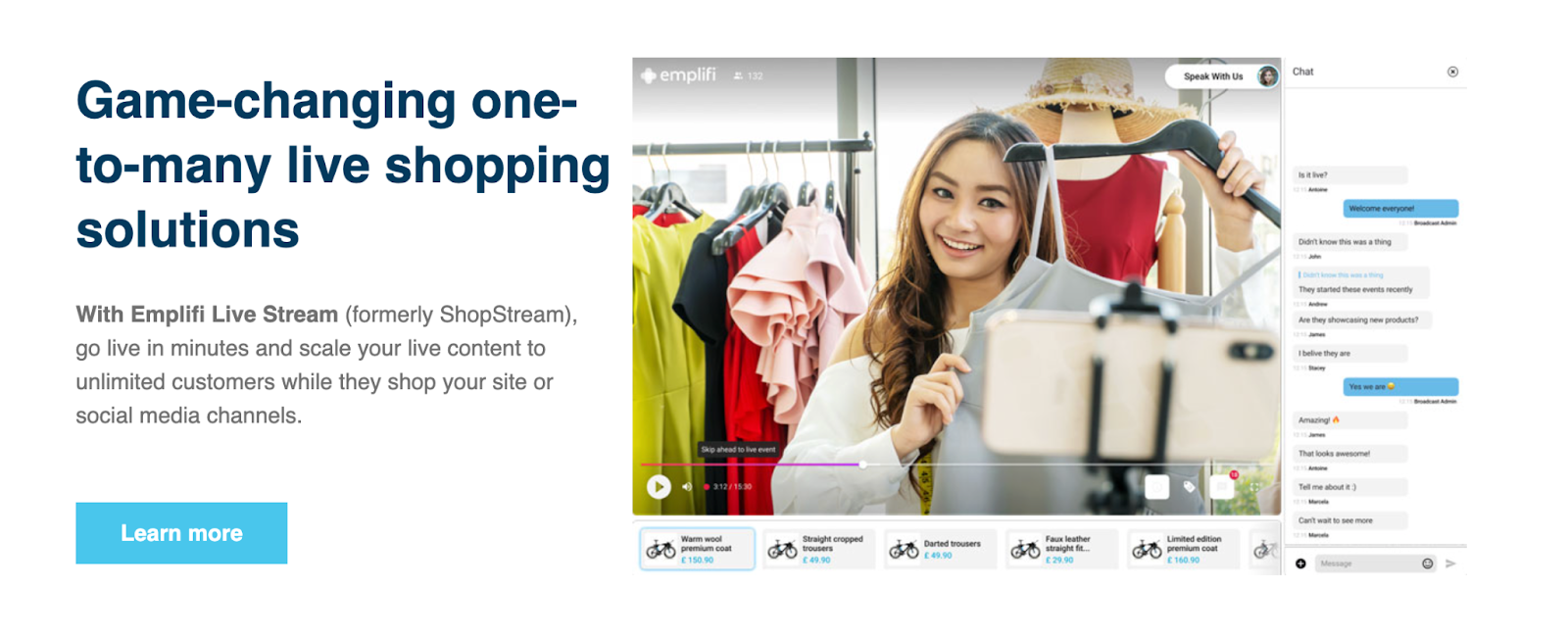
The Emplify platform (source)
3. Live shopping platforms
Finally, we have live shopping platforms, which are accessible to everyone from consumers who want to share their love for products to influencers and brands.
What makes live shopping platforms different from live shopping tools is discoverability: customers can browse dozens of live shows and potentially find your platform without depending on your marketing efforts to reach them.
Here are some of the most popular live shopping apps and platforms:
Amazon Live
Amazon Live helps creators and brands reach and connect with shoppers. According to Amazon, you can livestream on the platform as long as you’re a US Professional Seller registered in Amazon Brand Registry, a US Vendor with an approved Amazon Store, or an Amazon Influencer.
In other words, if you sell your products on Amazon, you can give Amazon Live a try. Product carousels below the live video make it an immersed, familiar shopping experience.

Amazon Live example. (source)
ShopShops
ShopShops is a livestream shopping app for fashion, beauty, and lifestyle products. The company works with both companies—brands, stores, and independent retailers—and hosts who run livestream shopping shows.
As of April 2023, the platform counts around 2.7 million users across the United States, Europe, Asia, and the Middle East. Vertical live videos are the way to go on ShopShops, since the platform works as a mobile app.
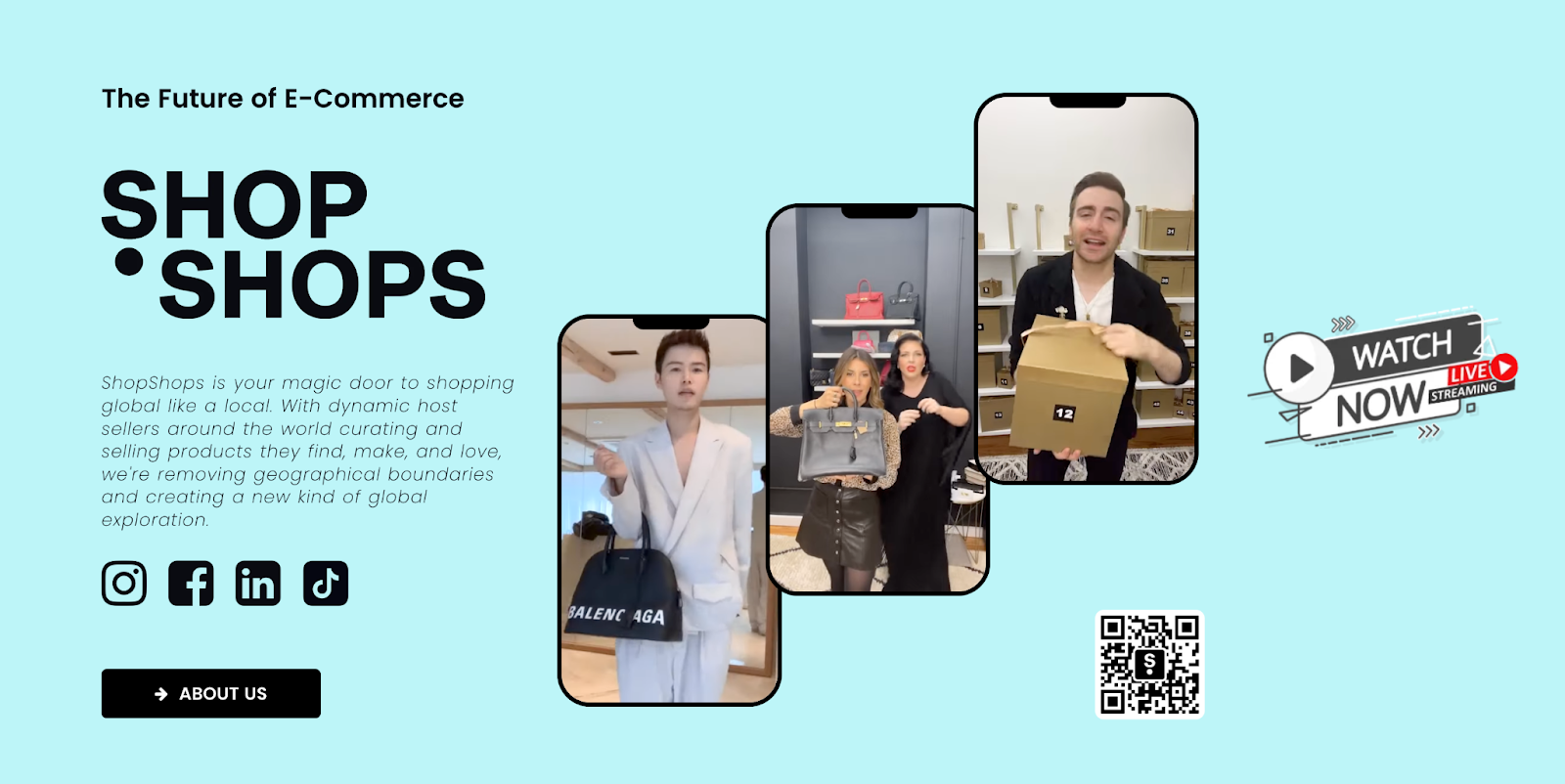
ShopShops’ website. (source)
TalkShopLive
TalkShopLive is a video commerce platform. With a built-in point-of-sale feature included within the video player, it makes selling and shopping seamless.
Big retailers like Walmart, artists like Kelly Clarkson and Ed Sheeran, and merchants like La Bella Donna all take advantage of TalkShopLive’s powerful capabilities. Viewers can find tutorials, limited edition products, and shopping guides throughout the platform and connect with their favorite brands and creators.
The best thing? You can integrate TalkShopLive right into your Shopify store.
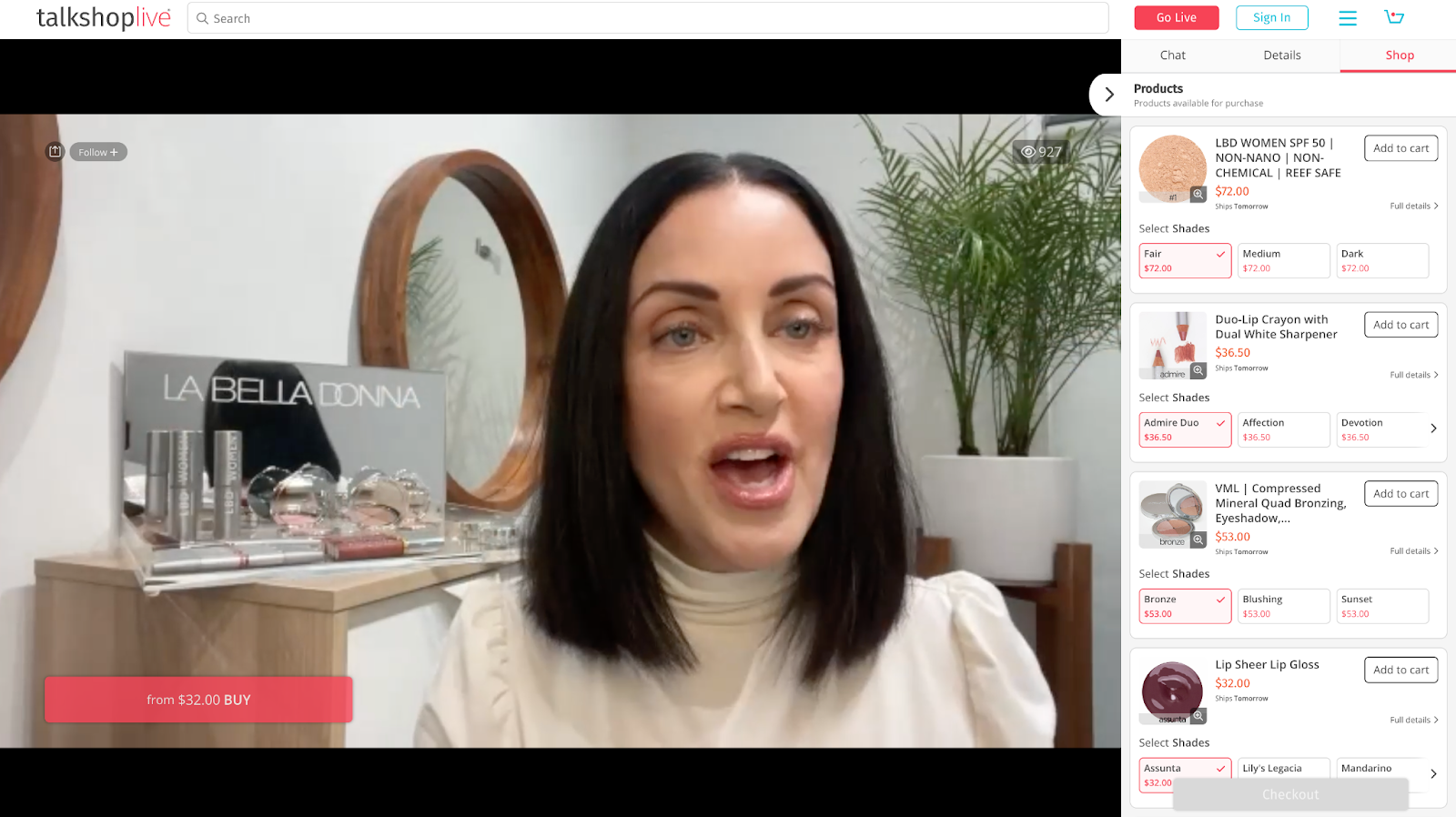
La Bella Donna live shopping event on TalkShopLive. (source)
NTWRK
NTWRK is a livestreaming video commerce platform built with Gen Z and millennial audiences in mind.
The layout of NTWRK’s website is designed to direct visitors toward the product categories they’re most interested in, like shoes, art, or accessories. Both individuals and brands can apply to sell through NTWRK.
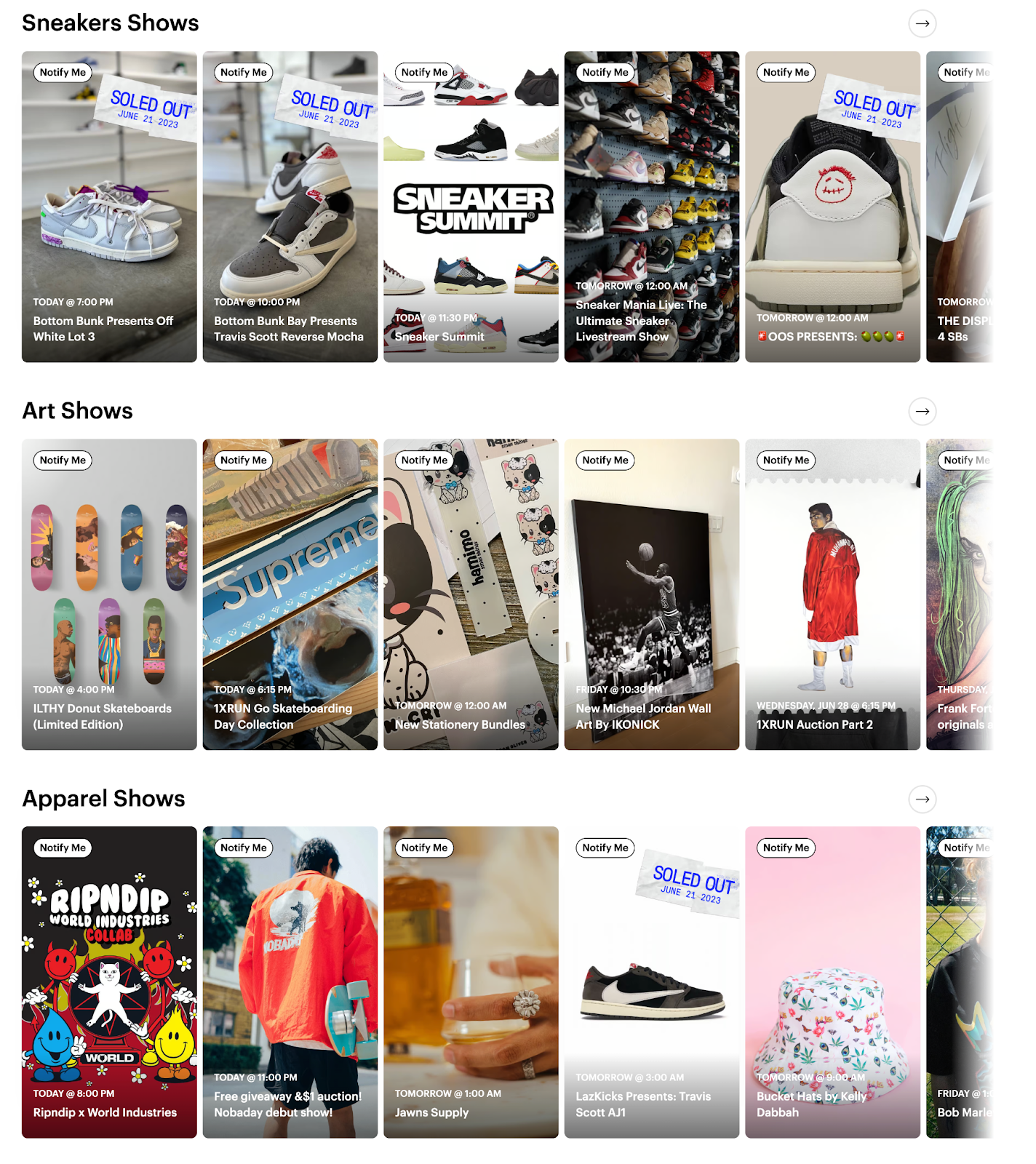
NTWRK’s show categories (source)
Live shopping best practices and tips
Get inspired by the brands already taking advantage of live shopping:
Offer exclusive bonuses and incentives to live viewers
FOMO—the fear of missing out—is a mighty motivator for taking action. When it comes to live shopping, it pays to give live viewers a unique offer—one they wouldn’t be able to get elsewhere. This will make them feel rewarded and respected for showing up and giving you their time and energy.
This unique offer can be a discount code, a free product with an order, a limited-edition product, or a giveaway—it’s up to you.
For example, POPFLEX pinned a comment with a discount code for viewers watching a live event leading up to Black Friday:
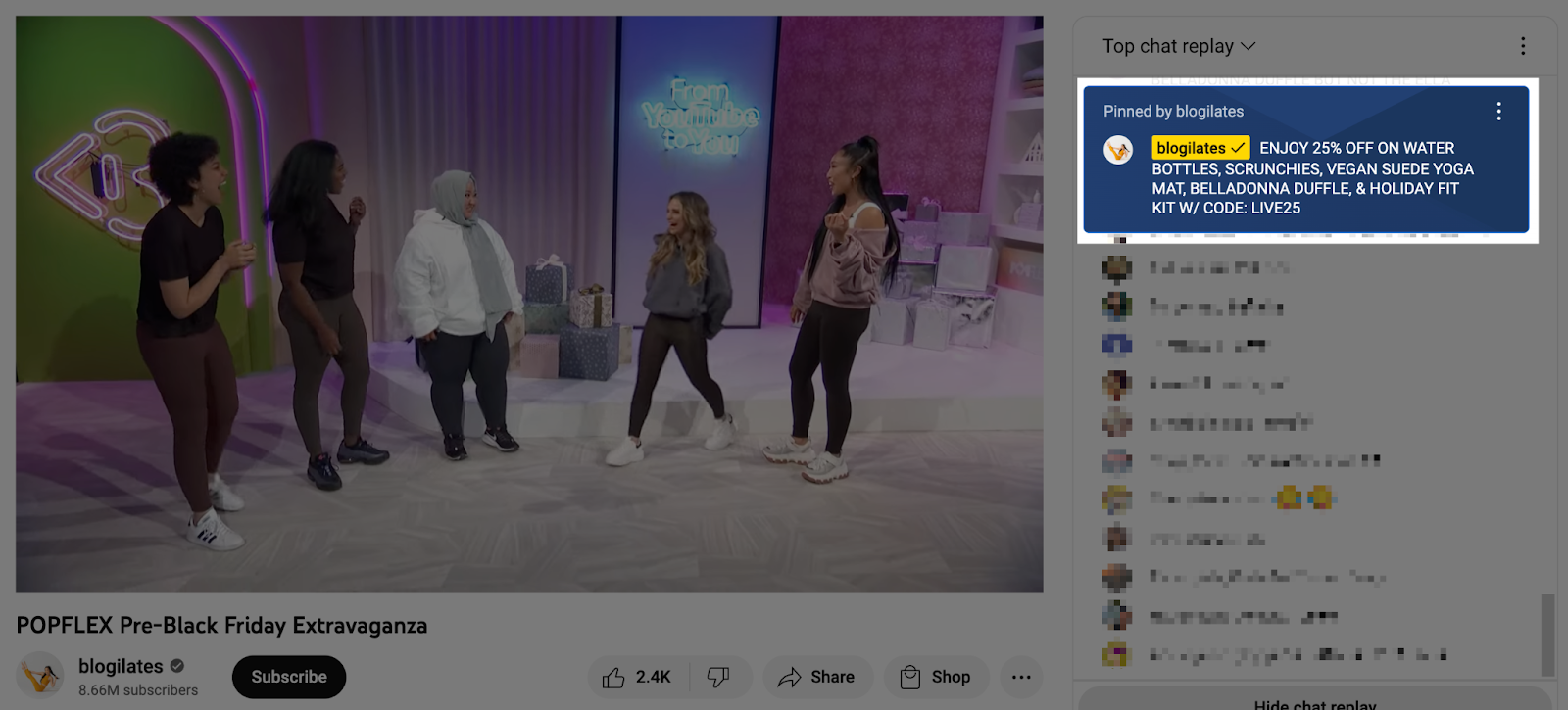
Discount code for live viewers during POPFLEX’s event. (source)
Integrate live shopping with your loyalty program
If you run a loyalty program, merging it with your livestreams can deepen the shopping experience for your viewers. For example, when a logged-in customer joins your live shopping event, you could add the products you’ve mentioned to a special product wish list in their account—or email them afterward with a recap.
The German drugstore dm utilizes this practice in its live shopping campaigns. In the Croatian market, dm runs live shopping sessions a couple of times per month and limits viewing to people with a shopping account. During the livestreams, experts discuss the topic of the session, and viewers can see products related to that topic by tapping on a list in the corner.
Not just that: Viewers who show up live receive a coupon that gives them extra points in their loyalty account if they end up making a purchase.
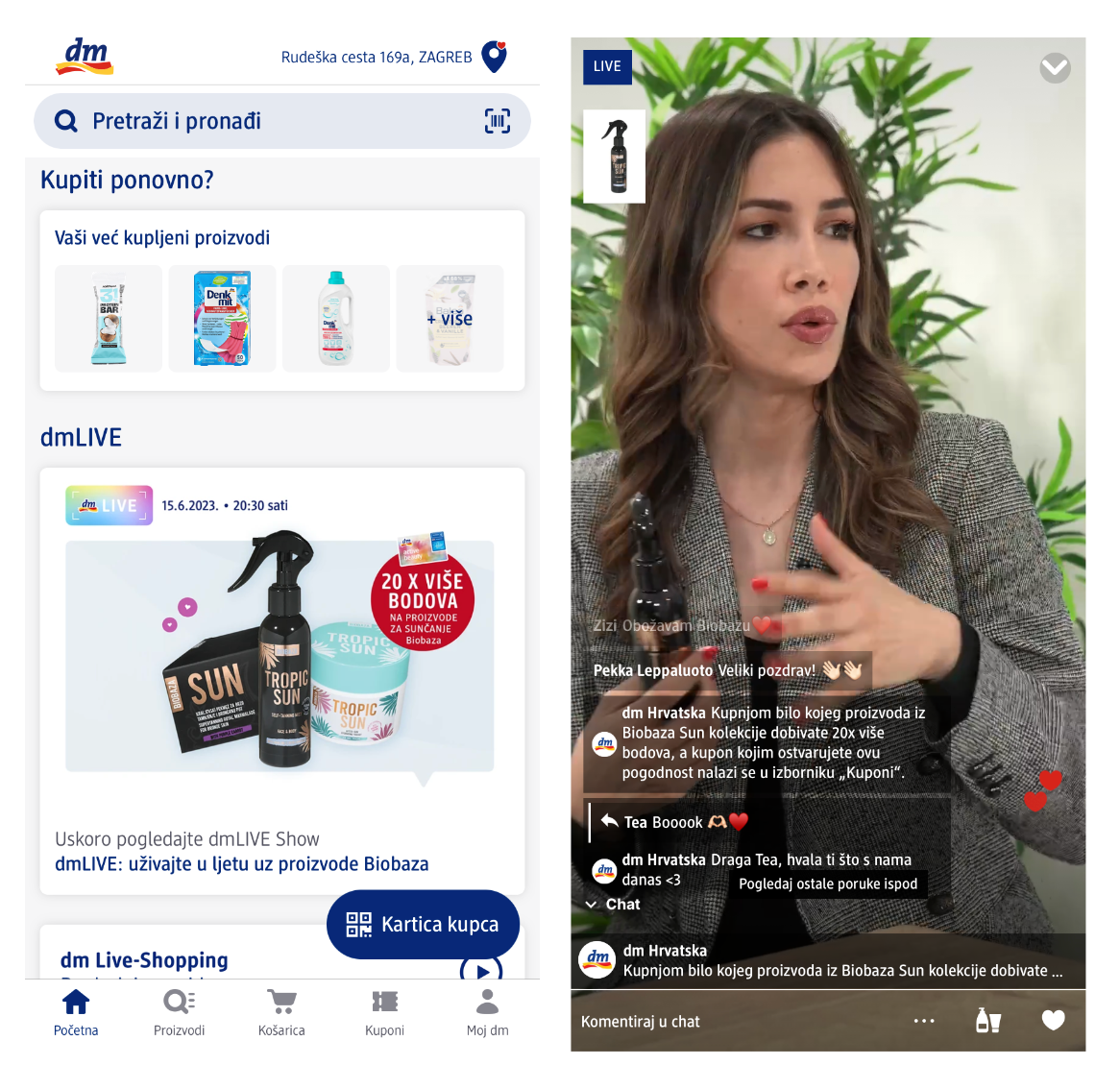
The dm app homepage promoting the live event (left) and the live event with a note about the extra points coupon (right).
Show deep knowledge of your products and who they’re best for
A live shopping experience can give viewers the confidence to buy the right product for their needs. It’s what makes live shopping so powerful as a strategy.
The best way to generate this confidence is to be specific when talking about a product. Instead of using vague statements that can sound exaggerated, talk about real-life experiences or benefits that people want from the product.
For example, if you’re talking about an SPF cream, instead of “This is the best SPF you’ll ever try,” say, “This SPF will work great for people with oily skin who want a lightweight SPF formula under their foundation.”
You can see this in action in a livestream run by the jewelry brand Celeste Sol. In the livestream, the brand’s founder and CEO, Tiffany Joachim, says, “If you have any aversion to weight on your ears, this is a great piece, because it’s light as air. It’s not gonna hurt or disrupt any feelings you may have on your ears.”
In other words, she offered a guaranteed solution to a specific problem.
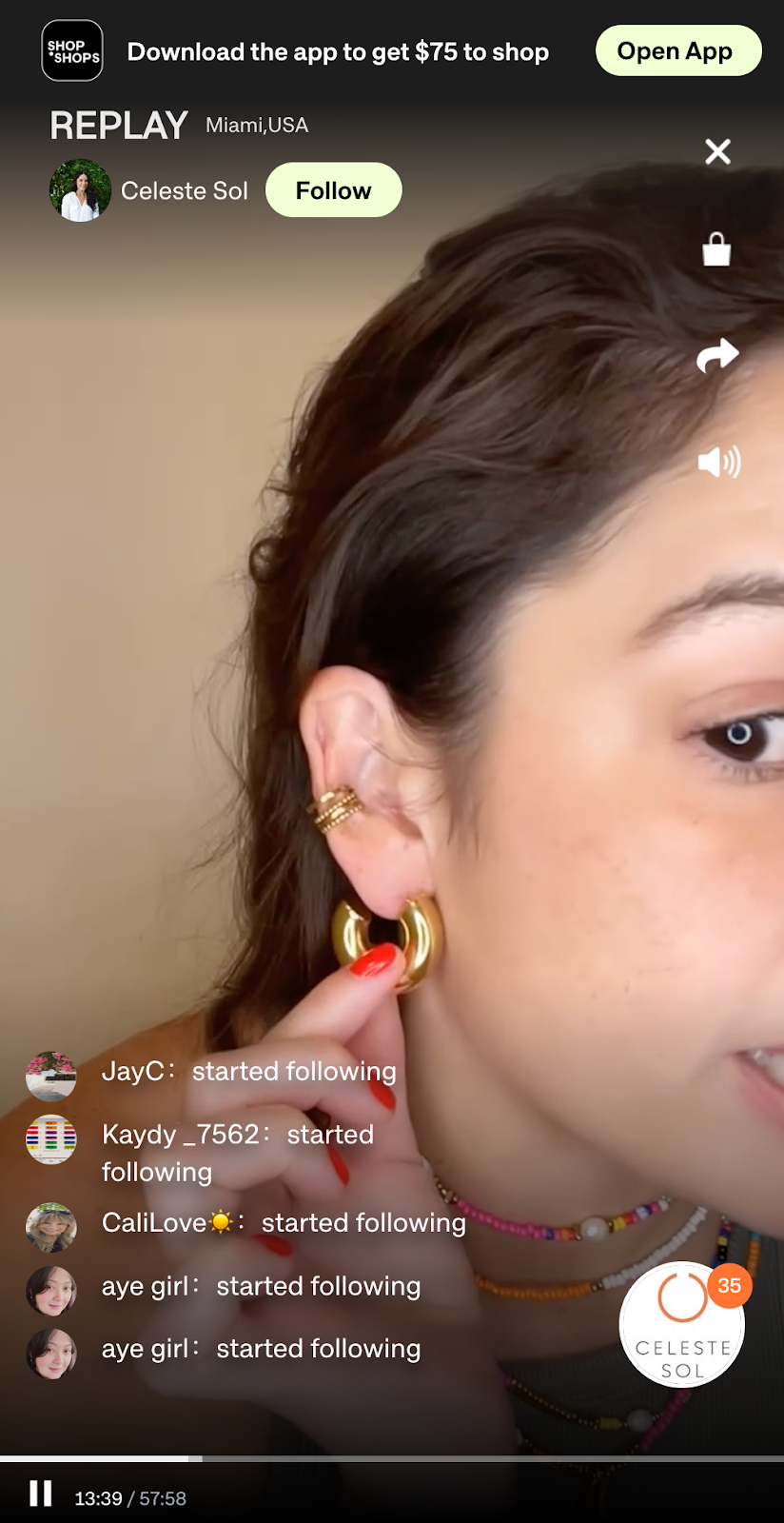
Celeste Sol’s live shopping event on ShopShops. (source)
Partner with influences or celebrities your audience loves
It’s worth joining forces with a name that your target audience already loves.
First, your existing customers and followers are more likely to join because it will give them a chance to engage with that person. And second, you’ll expand your reach because the person you’re partnering with is likely to attract some of their audience to the livestream.
The person or people you’re partnering with for the live shopping event can range from nano-influencers to big industry names, celebrities, and even related brands that aren’t your direct competitors.
Snug, a sofa company, partnered with comedian Katherine Ryan, which created a 160% growth in virtual consultation bookings and a 450% jump in sales after more than 6,000 users joined the livestream event.

The Twitter post promoting Snug’s live shopping event. (source)
This success was followed at another one of Snug’s events, one that was both in-person and livestreamed, where Snug featured noughties bands to appeal to its millennial consumer base. More than 11,600 people signed up to win tickets to the gig, and the event generated more than 100,000 social media impressions on event night.
Prioritize authenticity and engagement
Finally, live shopping is as two-way as it gets for a marketing and sales channel. If all you care about is speaking and not listening, your livestreams won’t land the way you want them to.
HeftyBerry, a brand that sells handmade wreaths and interior decorations, used an authenticity-focused approach and generated over $50,000 in sales over 24 hours with live shopping.
“You need to prioritize authenticity and engagement above all else,” says Ilia Mundut, HeftyBerry’s founder and CEO. “By creating an interactive experience for customers where they can ask questions and provide feedback in real-time, you create a sense of community around your brand that drives loyalty and repeat business.”
Take it from Printemps, a historic French department store that wanted to stay ahead of the curve by creating live shopping opportunities to connect with its customers. “We were committed to using internal skills to make live shopping an effective, long-term revenue and community-building tool,” Maud Funaro, Printemps’ chief transformation officer, said in a live shopping case study.
Printemps wants viewers and customers to feel comfortable with the experience, so it’s embedded live shopping right into its website. It crowdsourced its audience to vote for the timing of the livestreams, and the audience then gets to learn from the Printemps’ personal shoppers that they already know and love.
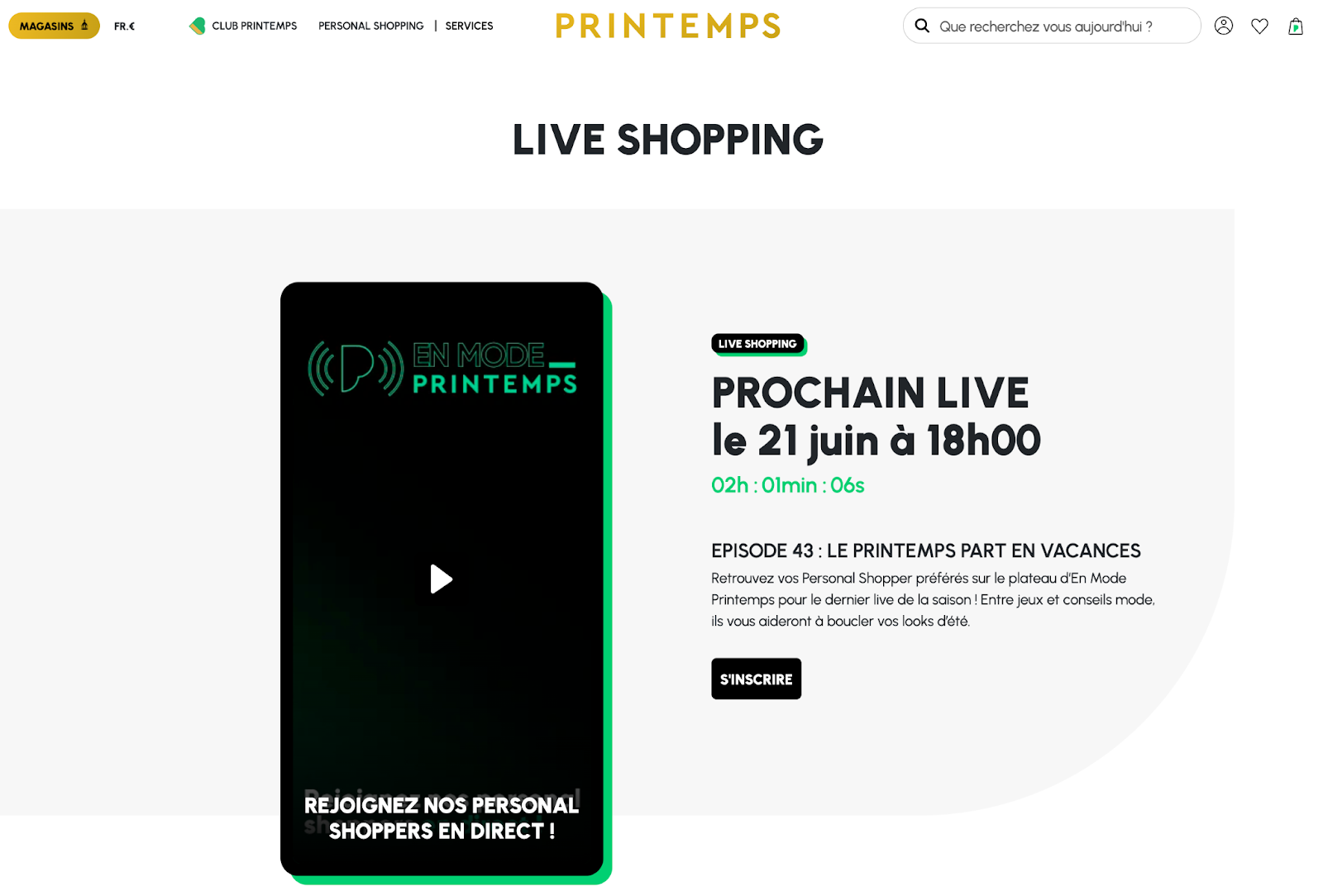
Printemps’ live shopping page. (source)
Wrapping up live shopping
There’s a chance your customers are craving more connection, more value from your products, and a more immersive experience with your brand—and live shopping can provide exactly that.
The future of ecommerce is about making online shopping more seamless and blended between channels than ever before. Whether you choose to livestream on your own or through partnerships, live shopping can drive engagement, growth, and long-term results for your ecommerce business.
Authenticity, personalization, and real conversations with your customers that come with live shopping = more trust, more sales, and more loyalty. It’s worth giving live shopping a chance.
Live shopping FAQ
What is online live shopping?
Online live shopping is a marketing strategy that merges live videos with online shopping features, letting viewers browse and purchase products in real time during a livestream.
What is a live sale?
A live sale is an online livestreaming event during which one or more hosts run product demonstrations or tutorials and invite viewers to leave comments, ask questions, and purchase products. Live sale events often drive higher conversion rates, lower return rates, and a highly engaged customer base.
What is TikTok live shopping?
TikTok live shopping allows brands to run livestreams with the goal to sell products, while viewers can browse and purchase products mentioned on the livestream without leaving the TikTok app.
How does live shopping work?
Live shopping has three elements: it takes place in video format, happens in real time, and links to products near the video screen. It can take place on social media, on live shopping platforms, or on the merchant’s website.
Livestream viewers can learn about products, ask questions about them through comments, and seamlessly check out, and often receive a special discount or offer as a reward for watching live.
